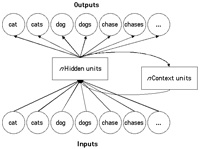 22) Recurrent connectivity in neural networks can elicit learning and reproduction of temporal sequences (Jordan – 1986, Elman – 1990, Schneider – 1991)
22) Recurrent connectivity in neural networks can elicit learning and reproduction of temporal sequences (Jordan – 1986, Elman – 1990, Schneider – 1991)
Powerful learning algorithms such as Hebbian learning, self-organizing maps, and backpropagation of error illustrated how categorization and stimulus-response mapping might be learned in the brain. However, it remained unclear how sequences and timing discrimination might be learned.
In 1986 Michael Jordan (the computer scientist, not the basketball player) developed a network of neuron-like units that fed back upon itself. Jeff Elman expanded on this, showing how these recurrent networks can learn to recognize sequences of ordered stimuli.
Elman applied his recurrent networks to the problem of language perception. He concluded that language relies heavily on recurrent connectivity in cortex; an unproven but well-accepted statement among many scientists today.
The year after Elman's demonstration of sequence learning with language, Walter Schneider (Schneider & Oliver, 1991) used a recurrent network to implement what he termed a 'goal processor'. This network can learn arbitrary task sequences, effectively expanding recurrent networks beyond language learning to learning new tasks of any type.
See this article for a review of a model implementing a goal processor.
The goal processor has been likened to a part of neocortex (dorsolateral prefrontal cortex) shown to be involved in maintaining goal information in working memory. Also, this maintenance is believed to occur via local (and/or via long-range fronto-parietal connections) recurrent connectivity.
Implication: The mind, largely governed by reward-seeking behavior on a continuum between controlled and automatic processing, is implemented in an electro-chemical organ with distributed and modular function consisting of excitatory and inhibitory neurons communicating via ion-induced action potentials over convergent and divergent synaptic connections altered by timing-dependent correlated activity often driven by expectation errors. The cortex, a part of that organ organized via local competition and composed of functional column units whose spatial dedication determines representational resolution, is composed of many specialized regions involved in perception (e.g., touch: parietal, vision: occipital), action (e.g., frontal), and memory (e.g., short-term: prefrontal, long-term: temporal), which depend on inter-regional connectivity for functional integration and recurrent connectivity for sequential learning.
[This post is part of a series chronicling history's top brain computation insights (see the first of the series for a detailed description). See the history category archive to see all of the entries thus far.]
-MC
